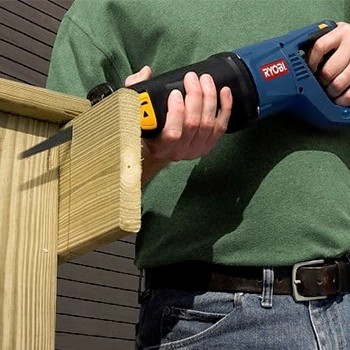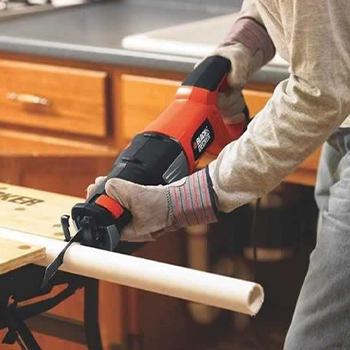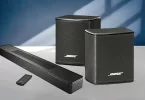It becomes difficult to point out the difference between things that seem so similar in functionalities and features. Saber saw and reciprocating saw are also listed in that category. There is quite a lot of confusion when it comes to these tools.
In this article, we will explore some of the dissimilarities between these power tools. Moreover, we will dig various usages and applications of saber and reciprocating saw. Read this saber saw vs. reciprocating saw review to find the differences and link them.
What is a Saber Saw?


A saber saw is one of the power tools that is quite handy and is utilized to cut metal or wood. The blade in this saw moves in a reciprocating motion. Consequently, we can say that a saber saw is a type of reciprocating saw.
It is true that they both are different in some certain ways, but a reciprocating saw is a wholesome tool while a saber saw is something that only has the capacity to move in such motion. There are a number of people who prefer a saber saw because of its capacity for demolition, but if you want cuts with precision, then a jigsaw is what you need.
A saber saw is larger than a jigsaw, but it does not possess the qualities which a jigsaw has. Jigsaw has more credibility than a saber saw, and it can be used for accurate cuts.
Reciprocating Saw; The Definition


A reciprocating saw is a kind of power tool in which the blade moves in the push and pull motion. This powered machine is widely used in construction and demolition work. Unlike the saber saw, the reciprocating one resembles the jigsaw.
This comes with a handle that makes it easy and comfortable to use on vertical surfaces. It is designed in a way that there is a foot at the base of the blade, which again is a similarity of this saw to the sharp cutting saws; jigsaw.
One can place the foot on the desired surface and cut it without any kind of hassle. This will move in a reciprocating motion and demolition the exterior space with efficiency. Let us see more in this saber saw vs. reciprocating saw overview.
Difference Between Reciprocating Saw and Saber Saw
It is quite hard to pinpoint the differences between reciprocating and saber saw. Owing to their similar functionalities, it seems that they just have different names but the same machines that perform similar tasks.
However, we have listed down some key differences that you need to keep in mind before choosing one of them.
The Design
Both of these tools are designed to be used on vertical surfaces. Their shapes are quite similar, and roles are alike as well. The inspiration for designing a saber saw is a sword. Its blade is in the front and handle at the back. This makes it very much handy and convenient.
The blades of both machines move in a reciprocating motion. However, it should be noted that they do not have the ability to cut with accuracy like a jigsaw. But we can say that a saber saw can work more efficiently than a reciprocating saw.
However, it should be noted that saber saw is more efficient for the soft surfaces and not for the rough ones.
| Reciprocating Saw | Saber Saw | |
| Design | Reciprocating saw is designed to be used on vertical surfaces. It’s cordless and has a foot at the base of the blade to control its movement while working. |
Saber saw design is like a sword, it has a handle at the back and blade at the front. |
| Nature of Excellence | Reciprocating saw has the tendency to cut through the rough and hard textured material. | Saber saw is considered best to cut the soft surfaces. It does not perform well on the rough stock. |
| Strength of Both Saws | Reciprocating saw is more reliable when it comes to durability and reliance. Highly recommended for the strong demolition work. |
Saber saw is a right tool for performing general woodworking. It is not that reliable but can work efficiently with the soft surfaces. |
The Nature of Excellence
Both the powered machines have the tendency to cut metals and wood. The blade that is used in a reciprocating saw can be molded through 90 degrees so, it has the capacity to reach in the places which otherwise cannot be accessed.
Moreover, it is designed with a comparatively longer blade that is more likely to cut through the surface up to 1 foot. In this manner, the reciprocating saw is more reliable than the saber. For saber saw does not possess the powerful motor to perform the rigorous task.
The only difference between the two is that the saber saw is not suitable for the larger tasks, while the reciprocating saw can work on the thick materials and can pierce through the surface in a more efficient manner.
Also, you can fix a pruning blade in the reciprocating saw and use it in the garden for more versatile tasks.
| Relevant Read: Difference between Uses of Reciprocating Saw Vs. Sawzall |
The Strengths of Reciprocating Saw and Saber Saw
From the information mentioned above, it can be deduced that both of these tools have identical shapes and functionality. But when it comes to durability and resilience, the reciprocating saw is what you need.
Reciprocating saw is designed to perform more powerful tasks with ease and convenience. It does not leave you disappointed when it comes to cut the hard surfaces and smoothly works on them. This added feature makes the reciprocating saw more expensive than the saber.
We recommend you to go for the reciprocating saw if you need strong demolition work.
But you can opt for a saber saw if you just need to perform the general woodworking. It is comparatively cheaper than reciprocating saw.
Hence, it will be a favorable option for those who want value at an affordable price. We are sure that it will not disappoint you at all.
The Potential Usage of Saber Saw
The usage of the saber saw is almost the same as the reciprocating saw. However, their capacity and power differ from each other. Saber saw works great when it comes to cutting soft surfaces. Moreover, its circular and angled cuts are even better than a jigsaw.
Saber saw is mostly used for relatively smaller jobs. Also, it is easy to handle a saber saw than a reciprocating saw. We can conveniently say that if you do not have a larger and rough surface to work on, then a saber saw is for you.
The Functions of Reciprocating Saw


Reciprocating saw’s functions are versatile in nature. It can perform several tasks, including metal cutting, gardening, PVC cutting, and demolition of even hard and rough surfaces.
Take a look below to get an idea of how it works for these tasks:
1: Gardening
You might be wondering how reciprocating saw can help you with gardening? As mentioned earlier, it is versatile in nature, and by fixing a pruning blade in a reciprocating saw, you can cut the overgrown shrubs and twigs.
Moreover, it can even be used to cut a whole tree. It makes gardening an easy job and spares you from the pain of manual work.
2: Metal Cutting
Reciprocating saw can conveniently cut metals, pins, nails, and pipes. Furthermore, you can also cut metal windows with high convenience and effortlessness.
3: Demolition
Reciprocating saw should be your number one choice when it comes to demolishing drywall, doors, windows, and furniture. It has the potential to deal with hard surfaces with such efficacy that it will become your favorite tool to work with.
The Bottom Line
There is no doubt that reciprocating and saber saw have such minute and camouflage differences that many people confuse them to be the same in functions and usages. However, with the information mentioned above, you can deduce the key differences between them.
Know the nature of your work and choose the saw that will perform your tasks in the most efficient manner. In this article, we have covered all the vital features of these powerful tools for your convenience. So, choose away your ideal pick and make your work easy.
FAQs
Q1: Is the saber saw same as the reciprocating saw?
Ans: Saber saw and reciprocating saw are the powered tools that are used to perform various functions. The saber saw’s blade moves in a reciprocating motion; hence, we can also call it a reciprocating saw.
But the motor and power of these tools differ from each other. Reciprocating saw can be used for rough and hard surfaces, while a saber saw is more suitable for cutting soft textured surfaces.
Q2: Do you need a saber saw?
Ans: Saber saw is a must-have tool, and it is a valuable addition to your toolkit. It is quite versatile in nature, and it has the ability to cut different materials with ease.
Q3: Can I use a reciprocating saw instead of a circular one?
Ans: It totally depends on your work requirements. The circular saw is used for accurate and clean cutting. In contrast, reciprocating saws are great for demolition rough surfaces, while circular saws for daily household projects.
Q4: Is reciprocating saw safe to use?
Ans: Reciprocating saws are a little difficult to handle. They must be used with great care and caution; otherwise, they can be quite hazardous.






